
- 資料結構與演算法
- DSA - 首頁
- DSA - 概述
- DSA - 環境設定
- DSA - 演算法基礎
- DSA - 漸進分析
- 資料結構
- DSA - 資料結構基礎
- DSA - 資料結構和型別
- DSA - 陣列資料結構
- 連結串列
- DSA - 連結串列資料結構
- DSA - 雙向連結串列資料結構
- DSA - 迴圈連結串列資料結構
- 棧與佇列
- DSA - 棧資料結構
- DSA - 表示式解析
- DSA - 佇列資料結構
- 搜尋演算法
- DSA - 搜尋演算法
- DSA - 線性搜尋演算法
- DSA - 二分搜尋演算法
- DSA - 插值搜尋
- DSA - 跳躍搜尋演算法
- DSA - 指數搜尋
- DSA - 斐波那契搜尋
- DSA - 子列表搜尋
- DSA - 雜湊表
- 排序演算法
- DSA - 排序演算法
- DSA - 氣泡排序演算法
- DSA - 插入排序演算法
- DSA - 選擇排序演算法
- DSA - 歸併排序演算法
- DSA - 希爾排序演算法
- DSA - 堆排序
- DSA - 桶排序演算法
- DSA - 計數排序演算法
- DSA - 基數排序演算法
- DSA - 快速排序演算法
- 圖資料結構
- DSA - 圖資料結構
- DSA - 深度優先遍歷
- DSA - 廣度優先遍歷
- DSA - 生成樹
- 樹資料結構
- DSA - 樹資料結構
- DSA - 樹的遍歷
- DSA - 二叉搜尋樹
- DSA - AVL 樹
- DSA - 紅黑樹
- DSA - B 樹
- DSA - B+ 樹
- DSA - 伸展樹
- DSA - 字典樹
- DSA - 堆資料結構
- 遞迴
- DSA - 遞迴演算法
- DSA - 使用遞迴實現漢諾塔
- DSA - 使用遞迴實現斐波那契數列
- 分治法
- DSA - 分治法
- DSA - 最大最小問題
- DSA - Strassen 矩陣乘法
- DSA - Karatsuba 演算法
- 貪心演算法
- DSA - 貪心演算法
- DSA - 旅行商問題(貪心演算法)
- DSA - Prim 最小生成樹
- DSA - Kruskal 最小生成樹
- DSA - Dijkstra 最短路徑演算法
- DSA - 地圖著色演算法
- DSA - 分數揹包問題
- DSA - 帶截止日期的作業排序
- DSA - 最佳合併模式演算法
- 動態規劃
- DSA - 動態規劃
- DSA - 矩陣鏈乘法
- DSA - Floyd Warshall 演算法
- DSA - 0-1 揹包問題
- DSA - 最長公共子序列演算法
- DSA - 旅行商問題(動態規劃)
- 近似演算法
- DSA - 近似演算法
- DSA - 頂點覆蓋演算法
- DSA - 集合覆蓋問題
- DSA - 旅行商問題(近似演算法)
- 隨機化演算法
- DSA - 隨機化演算法
- DSA - 隨機化快速排序演算法
- DSA - Karger 最小割演算法
- DSA - Fisher-Yates 洗牌演算法
- DSA 有用資源
- DSA - 問答
- DSA - 快速指南
- DSA - 有用資源
- DSA - 討論
Fisher-Yates 洗牌演算法
Fisher-Yates 洗牌演算法透過生成隨機排列來對有限序列的元素進行洗牌。每個排列出現的可能性是均等的。該演算法透過將序列的元素儲存在一個袋子中,並從袋子中隨機抽取每個元素來形成洗牌後的序列。
該演算法以 Ronald Fisher 和 Frank Yates 的名字命名,他們設計了最初的洗牌方法,該演算法是無偏的。它在相同條件下生成所有排列,因此獲得的輸出不受任何影響。然而,Fisher-Yates 演算法的現代版本比原始版本更有效率。
Fisher-Yates 演算法
原始方法
洗牌演算法的原始方法涉及使用筆和紙來生成有限序列的隨機排列。生成隨機排列的演算法如下:
步驟 1 - 寫下有限序列中的所有元素。宣告一個單獨的列表來儲存獲得的輸出。
步驟 2 - 在輸入序列中隨機選擇一個元素 i 並將其新增到輸出列表中。將元素 i 標記為已訪問。
步驟 3 - 重複步驟 2,直到有限序列中的所有元素都被訪問並隨機新增到輸出列表中。
步驟 4 - 程序終止後生成的輸出列表是生成的隨機排列。
現代演算法
現代演算法是對原始 Fisher-Yates 洗牌演算法的略微修改版本。修改的主要目標是透過降低原始方法的時間複雜度來使原始演算法計算機化。現代方法由 Richard Durstenfeld 開發,並由 Donald E. Knuth 推廣。
因此,現代方法使用交換而不是維護另一個輸出列表來儲存生成的隨機排列。時間複雜度從 O(n2) 降低到 O(n)。演算法如下:
步驟 1 - 將元素 1 到 n 寫入有限序列中。
步驟 2 - 在輸入序列中隨機選擇一個元素 i 並將其與列表中最後一個未訪問的元素交換。
步驟 3 - 重複步驟 2,直到有限序列中的所有元素都被訪問並交換。
步驟 4 - 程序終止後生成的列表是隨機排列序列。
虛擬碼
以下現代方法虛擬碼中,洗牌是從陣列的最高索引到最低索引進行的。
Fisher-Yates Shuffle (array of n elements): for i from n−1 downto 1 do j ← random integer such that 0 ≤ j ≤ i exchange a[j] and a[i]
以下現代方法虛擬碼中,洗牌是從陣列的最低索引到最高索引進行的。
Fisher-Yates Shuffle (array of n elements): for i from 0 to n−2 do j ← random integer such that i ≤ j < n exchange a[i] and a[j]
原始方法示例
為了更好地描述該演算法,讓我們對字母表的前六個字母給定的有限序列進行排列。輸入序列:A B C D E F。
步驟 1
這稱為筆和紙方法。我們考慮一個儲存有限序列的輸入陣列和一個儲存結果的輸出陣列。

步驟 2
隨機選擇任何元素並將其新增到輸出列表中,然後將其標記為已檢查。在本例中,我們選擇元素 C。
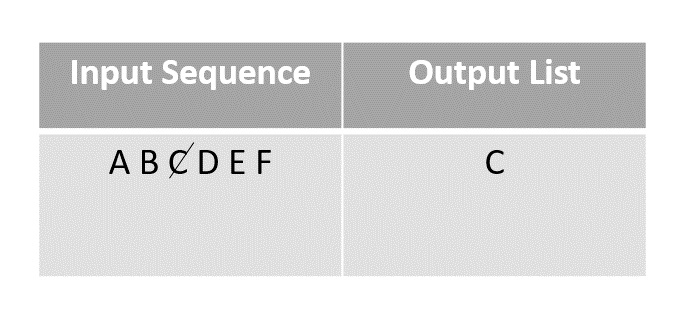
步驟 3
接下來隨機選擇的元素是 E,它被標記並新增到輸出列表中。

步驟 4
然後隨機函式選擇下一個元素 A 並將其新增到輸出陣列中,然後將其標記為已訪問。
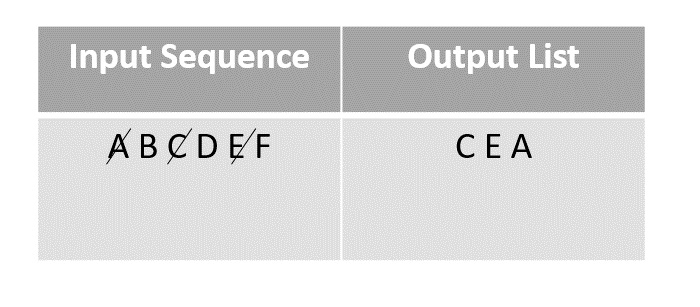
步驟 5
然後從輸入序列中剩餘的元素中選擇 F 並將其新增到輸出中,然後將其標記為已訪問。
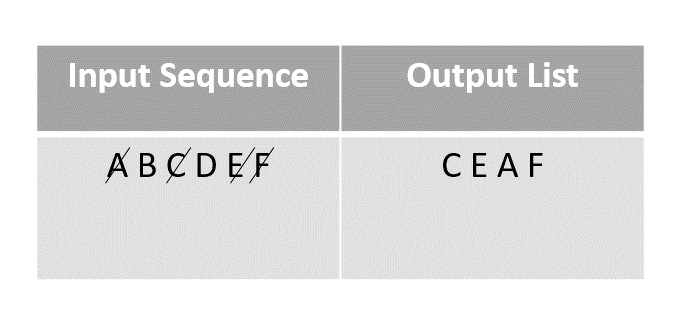
步驟 6
下一個要新增到隨機排列中的元素是 D。它被標記並新增到輸出陣列中。
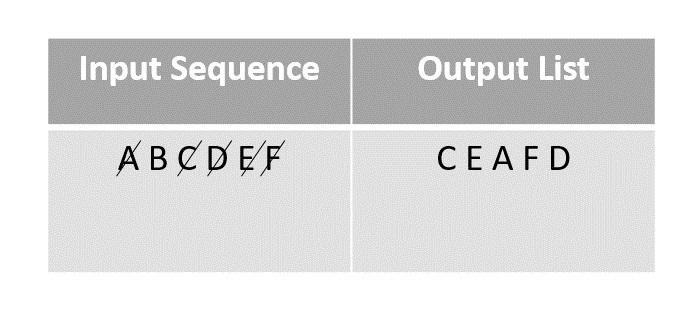
步驟 7
輸入列表中最後一個元素將是 B,因此它被標記並最終新增到輸出列表中。
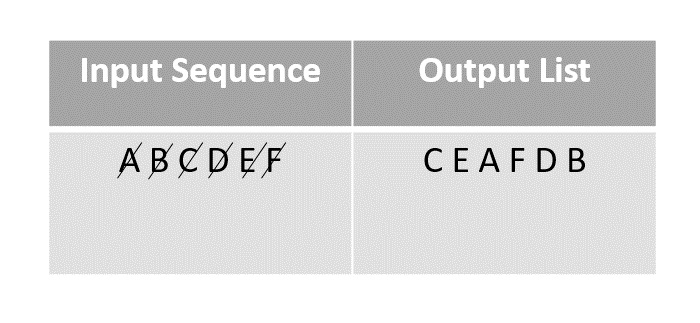
現代方法示例
為了降低原始方法的時間複雜度,引入了現代演算法。現代方法使用交換來洗牌序列 - 例如,該演算法的工作原理類似於透過交換原始牌組中的位置來洗牌一副紙牌。讓我們來看一個例子,瞭解 Fisher-Yates 演算法的現代版本是如何工作的。
步驟 1
將字母表的前幾個字母作為輸入,並使用現代方法對其進行洗牌。

步驟 2
隨機選擇元素 D 並將其與序列中最後一個未標記的元素(在本例中為 F)交換。
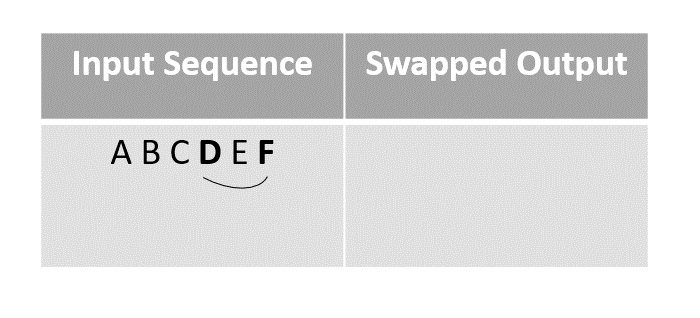
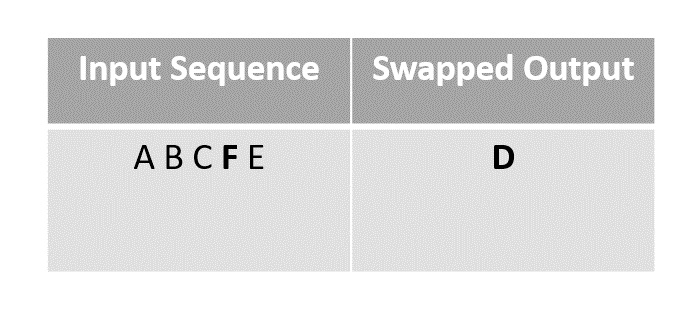
步驟 3
下一步,我們選擇元素 B 與最後一個未標記的元素“E”交換,因為在前面的步驟中,F 與 D 交換後被移動到 D 的位置。
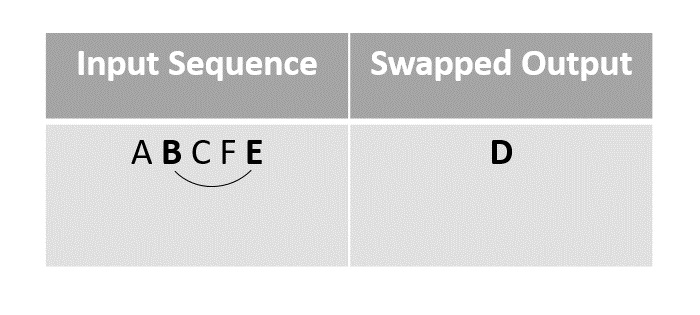
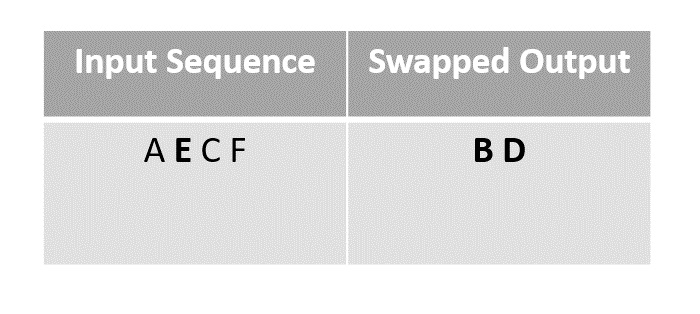
步驟 4
接下來,我們將元素 A 與 F 交換,因為它是在列表中最後一個未標記的元素。
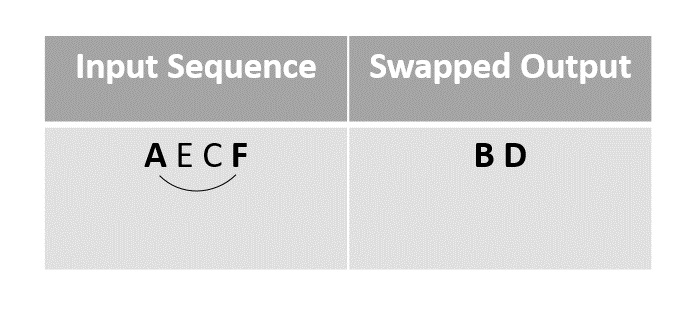

步驟 5
然後元素 F 與最後一個未標記的元素 C 交換。
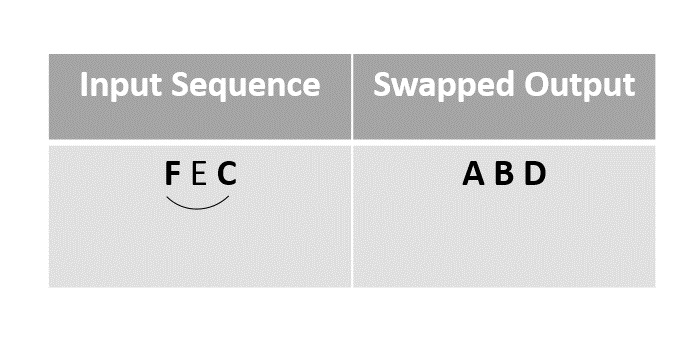
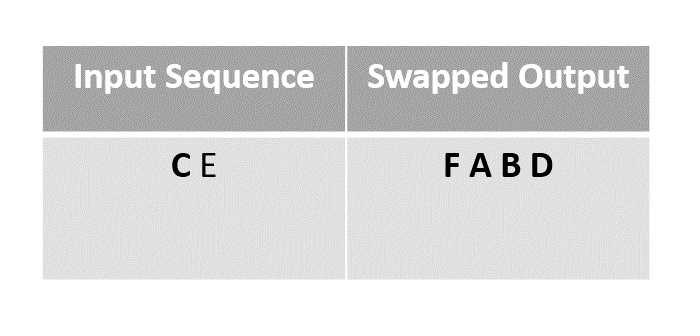
步驟 6
序列中剩餘的元素最終可以交換,但由於隨機函式選擇了 E 作為元素,因此它保持不變。
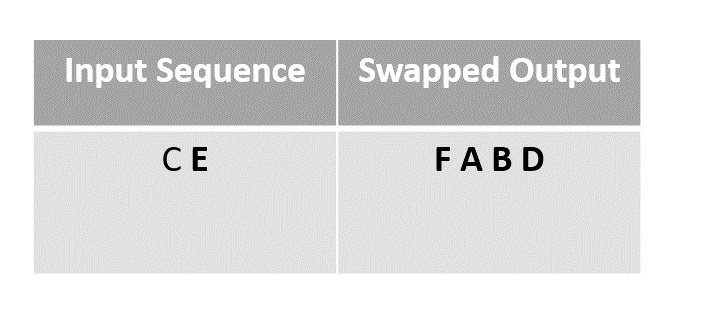
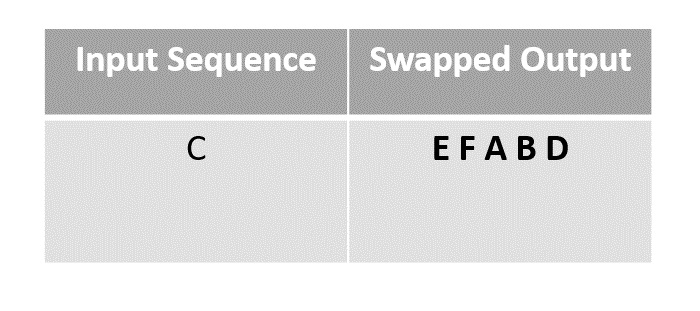
步驟 7
剩餘的元素 C 保持不變,無需交換。
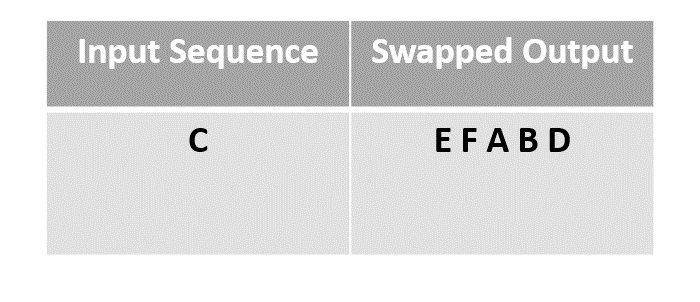

交換後獲得的陣列是最終的輸出陣列。
示例
以下是上述方法在各種程式語言中的實現:
#include <stdio.h>
#include <stdlib.h>
#include <time.h>
// Function to perform Fisher-Yates Shuffle using the original method
void fisherYatesShuffle(char arr[], char n) {
char output[n]; // Create an output array to store the shuffled elements
char visited[n]; // Create a boolean array to keep track of visited elements
// Initialize the visited array with zeros (false)
for (char i = 0; i < n; i++) {
visited[i] = 0;
}
// Perform the shuffle algorithm
for (char i = 0; i < n; i++) {
char j = rand() % n; // Generate a random index in the input array
while (visited[j]) { // Find the next unvisited index
j = rand() % n;
}
output[i] = arr[j]; // Add the element at the chosen index to the output array
visited[j] = 1; // Mark the element as visited
}
// Copy the shuffled elements back to the original array
for (char i = 0; i < n; i++) {
arr[i] = output[i];
}
}
int main() {
char arr[] = {'A', 'B', 'C', 'D', 'E', 'F'};
char n = sizeof(arr) / sizeof(arr[0]);
srand(time(NULL)); // Seed the random number generator with the current time
fisherYatesShuffle(arr, n); // Call the shuffle function
printf("Shuffled array: ");
for (char i = 0; i < n; i++) {
printf("%c ", arr[i]); // Print the shuffled array
}
printf("\n");
return 0;
}
輸出
Shuffled array: A B F D E C
#include <iostream>
#include <vector>
#include <algorithm>
#include <random>
// Function to perform Fisher-Yates Shuffle using the original method
void fisherYatesShuffle(std::vector<char>& arr) {
std::vector<char> output; // Create an output vector to store the shuffled elements
std::vector<bool> visited(arr.size(), false); // Create a boolean vector to keep track of visited elements
// Perform the shuffle algorithm
for (char i = 0; i < arr.size(); i++) {
char j = rand() % arr.size(); // Generate a random index in the input vector
while (visited[j]) { // Find the next unvisited index
j = rand() % arr.size();
}
output.push_back(arr[j]); // Add the element at the chosen index to the output vector
visited[j] = true; // Mark the element as visited
}
arr = output; // Copy the shuffled elements back to the original vector
}
int main() {
std::vector<char> arr = {'A', 'B', 'C', 'D', 'E', 'F'};
srand(time(NULL)); // Seed the random number generator with the current time
fisherYatesShuffle(arr); // Call the shuffle function
std::cout << "Shuffled array: ";
for (char c : arr) {
std::cout << c << " "; // Print the shuffled array
}
std::cout << std::endl;
return 0;
}
輸出
Shuffled array: D B A F C E
import java.util.ArrayList;
import java.util.List;
import java.util.Random;
public class FisherYatesShuffle {
// Function to perform Fisher-Yates Shuffle using the original method
public static List<Character> fisherYatesShuffle(List<Character> arr) {
List<Character> output = new ArrayList<>(); // Create an output list to store the shuffled elements
boolean[] visited = new boolean[arr.size()]; // Create a boolean array to keep track of visited elements
// Perform the shuffle algorithms
for (int i = 0; i < arr.size(); i++) {
int j = new Random().nextInt(arr.size()); // Generate a random index in the input list
while (visited[j]) { // Find the next unvisited index
j = new Random().nextInt(arr.size());
}
output.add(arr.get(j)); // Add the element at the chosen index to the output list
visited[j] = true; // Mark the element as visited
}
return output;
}
public static void main(String[] args) {
List<Character> arr = List.of('A', 'B', 'C', 'D', 'E', 'F');
Random rand = new Random(); // Seed the random number generator with the current time
List<Character> shuffledArray = fisherYatesShuffle(arr); // Call the shuffle function
System.out.print("Shuffled array: ");
for (char c : shuffledArray) {
System.out.print(c + " "); // Print the shuffled array
}
System.out.println();
}
}
輸出
Shuffled array: D B E C A F
import random
# Function to perform Fisher-Yates Shuffle using the original method
def fisherYatesShuffle(arr):
output = [] # Create an output list to store the shuffled elements
visited = [False] * len(
arr) # Create a boolean list to keep track of visited elements
# Perform the shuffle algorithm
for i in range(len(arr)):
j = random.randint(0,
len(arr) -
1) # Generate a random index in the input list
while visited[j]: # Find the next unvisited index
j = random.randint(0, len(arr) - 1)
output.append(
arr[j]) # Add the element at the chosen index to the output list
visited[j] = True # Mark the element as visited
return output
if __name__ == "__main__":
arr = ['A', 'B', 'C', 'D', 'E', 'F']
random.seed() # Seed the random number generator with the current time
shuffled_array = fisherYatesShuffle(arr) # Call the shuffle function
print("Shuffled array:", shuffled_array) # Print the shuffled array
輸出
Shuffled array: ['D', 'C', 'A', 'B', 'F', 'E']
